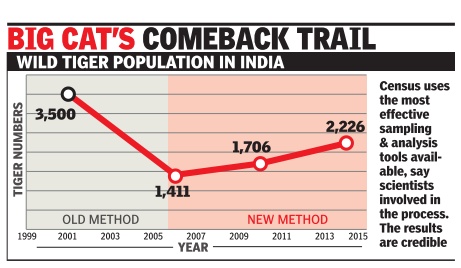Tigers: India
Contents |
Increase in Uttar Pradesh



Rise in No. of tigers in Uttar Pradesh
The Times of India TNN | Jul 27, 2014
LUCKNOW: Camera traps have shown more tigers in the core area of Dudhwa tiger reserve this time. The initial estimates for two years, 2011 to 2013, have shown 72 to 80 tigers in the core area of the reserve.
Tiger census 2010-11 had counted 118 tigers in Dudhwa reserve. "The final count this time might be around 125," said PCCF (wildlife), UP, Rupak De.
The findings have been sent to the Union ministry of environment and forest for screening, said the official.
Camera-trapping exercise has been done for Kishenpur wildlife sanctuary and Dudhwa national park which form core of the reserve. Initial findings have also come for Pilibhit forest division which is now a separate reserve.
In all, 72 to 80 tigers have been counted in these areas. Once figures for Katarniaghat wildlife sanctuary, North and South kheri forest division come, tiger numbers might go up to 125. The improved census technique could have resulted in more tigers getting recorded in camera.
It was an 'intensive' exercise as a pair of cameras was installed every 1.6 sq km of the core area. A pair of cameras was installed at 65 identified points in Kishenpur and at 206 identified points in Dudhwa national park.
The height at which cameras were mounted was also altered to record cubs, two-year old and less.
About a dozen new cubs have been recorded in camera.
At least 382 photographs have been downloaded from cameras installed in Kishenpur and Dudhwa national park.
Many of these photographs, said officials, could be 'repetitions' which is why the photographs would be screened. Tiger census is on since November 15 in the reserve.
UP has a major tiger population in Dudhwa tiger reserve comprising Dudhwa National Park (680 sq km), Kishenpur Sanctuary (204 sq km) and Katarniaghat Wildlife Sanctuary (440 sq km); Pilibhit (720 sq km); North Kheri (350 sq km) and South Kheri (460 sq km).
Smaller tiger populations are present in Bijnor forests in west and Suhelwa (Gonda-Bahraich) and Sohagibarwa wildlife sanctuaries (Maharajganj) in east.
2006-2014:high growth
Jan 21 2015
2,226 now: Tiger numbers grow by 30% in 4 years Camera trap and DNA sampling methods used in tiger census
Vishwa Mohan
There are more than 2,200 tigers in India's forests, the latest census reveals, indicating a sharp 30% rise in four years that'll come as a big boost to India's conservation efforts. The census, held in 2014, found evidence for 2,226 tigers, compared to 1,706 in 2010.
The southern states of Karnataka, Tamil Nadu and Kerala in the Western Ghats landscape recorded nearly one-third of the country's total number of big cats. Karnataka continues to have the highest number of tigers in India, itself home to 70% of the world's tiger population.The Mudumalai-BandipurNagarhole-Wayanad forest complex in Western Ghats holds the world's largest tiger population, with 570 tigers. If one compares the 2006 tiger census, when mod ern methodology was adopted for the first time, revealing a tiger population of just 1,411 -the overall increase across the country is a phenomenal 800-odd tigers in the past eight years.
Releasing the 2014 data on Tuesday , Union environment and forests minister Prakash Javadekar said, “We must be proud of our legacy . We have increased the number of tigers by over 30% from the last count (in 2010). “ A total of 3,78,118 sq km of forest area in 18 states, having tiger population, was surveyed during the census that used `double sampling' approach including ground survey and remote camera trapbased capture and recapture technique. Besides, scat DNA sampling method was also used for corroboration in many forest areas.
More than 9,730 cameras were used in the exercise, carried out by National Tiger Conservation Authority in collaboration with the state forest departments, national conservation NGOs and Wildlife Institute of India.
The exercise resulted in 1,540 individual tigers being photographed -making it the most authentic report on tiger population in the country.
The report shows that the tiger population has increased in Karnataka, Utta rakhand, Madhya Pradesh, Tamil Nadu and Kerala in the past four years, while it has decresed in Odisha and Jharkhand.
Valuation of tiger reserves in India
Jan 22 2015
6 tiger reserves worth Rs 1.5L cr: Valuation study
Vishwa Mohan
In a first of its kind exercise, India has conducted economic valuation of six of its tiger reserves and placed their value at Rs 1,49,900 crore. The study has also noted that these six reserves have been generating annual monetary benefits worth Rs 7,970 crore. The six tiger reserves which were surveyed for this study are Corbett, Kanha, Kaziranga, Periyar, Ranthambore and Sundarbans.
India has 47 tiger reserves covering over 2% of the area and approximately 10% of the recorded forest area. Latest tiger census shows that India -which is home to 70% of world's tiger population -has a total of 2,226 tigers.
The valuation study, executed by Indian Institute of Forest Management (IIFM), Bhopal, at the behest of the environment ministry's National Tiger Conservation Authority (NTCA), provides quantitative and qualitative estimates of benefits accruing from tiger reserves which include economic, social and cultural services.
“The study findings indicate that the monetary value of flow benefits emanating from selected tiger reserves range from Rs 830 crore to Rs 1,760 crore annually . In terms of unit area, this translates into Rs 50,000 to Rs 190,000 per hectare per year,“ said the summary of the report released simultaneous ly with the tiger census by the Union environment and forests minister Prakash Javadekar.
1999-2015: population





